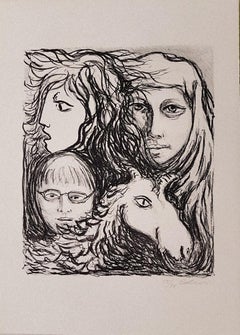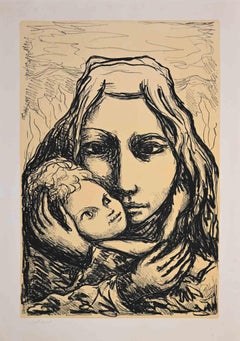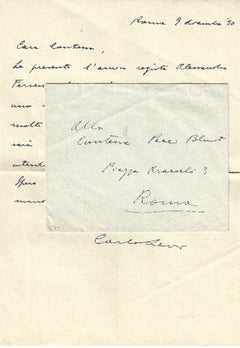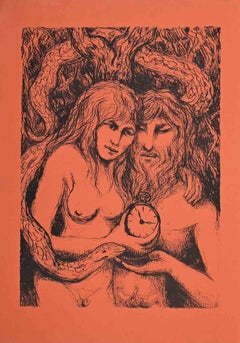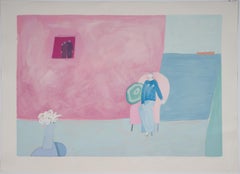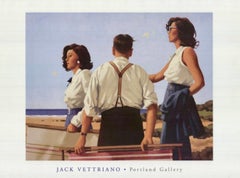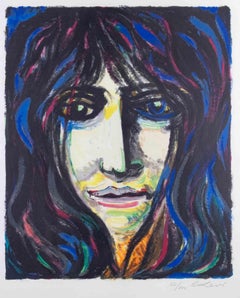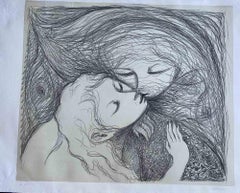Carlo Levi Art
to
1
1
2
Overall Width
to
Overall Height
to
4
1
1
2
2
3
1
3
3
3
2
1
1
3
1
1
4
10,083
2,779
1,379
1,375
4
Artist: Carlo Levi
The Motherhood - Lithograph by Carlo Levi - 1970s
By Carlo Levi
Located in Roma, IT
The Motherhood is an original lithograph on paper by Carlo Levi in 1960s
Hand-signed on the lower right.
Artist's proof.
good conditions except for a lon...
Category
1960s Contemporary Carlo Levi Art
Materials
Lithograph
Mother and Child - Lithograph by Carlo Levi - Mid-20th Century
By Carlo Levi
Located in Roma, IT
Mother and Child is an original litograph realized by Carlo Levi in mid-20th century.
Good condition.
Hand signed by the artist.
Carlo Levi (29 Novembe...
Category
Mid-20th Century Modern Carlo Levi Art
Materials
Lithograph
Autograph Letter by Carlo Levi - 1950
By Carlo Levi
Located in Roma, IT
This is an Autograph Letter Signed by Carlo Levi to the Countess A.L. Pecci Blunt.
Rome, December 9th 1950. In Italian. One page, single-sided. Excellent condition, perfecly readable. Including original envelope.
Carlo Levi (Tourin,1902 – Rome, 1975), the Italian painter, writer, activist, anti-fascist, best-known for his "Cristo si è fermato a Eboli" (Christ Stopped at Eboli),writes this letter to the Countess and patron of arts, A.L. Pecci Blunt to introduce the Italian playwright and director Alessandro Fersen (Łódź, 1911 - Rome, 2001). Artistic Intentions and common initiatives could arise.
The background:
In the same year of this letter, in 1950, Alessandro Fersen together with Walter Cantatore and Emanuele Luzzati...
Category
1950s Modern Carlo Levi Art
Materials
Paper, Ink
Adam and Eve - Lithograph by Carlo Levi - Mid 20th Century
By Carlo Levi
Located in Roma, IT
Adam and Eve is an original lithograph realized by Carlo Levi in mid-20th Century.
Good condition on a red cardboard.
Hand signed by the artist.
Carlo Levi (29 November 1902 – 4 ...
Category
Mid-20th Century Contemporary Carlo Levi Art
Materials
Lithograph
Related Items
Unframed "Seated Woman on Pink Chair" signed lithograph by artist Joy Laville
By Joy Laville
Located in Boca Raton, FL
Unframed "Seated Woman on Pink Chair" lithograph by artist Joy Laville. Signed H J Laville lower right recto. Image size: 31 x 43 inches.
Category
1980s Modern Carlo Levi Art
Materials
Lithograph
Young Hearts, Portland Gallery London offset lithograph
By Jack Vettriano
Located in Hillsborough, NC
Jack Vettriano (1951-) is renowned for his film noir oil paintings and 1930s glam style. Uniquely Vettriano, ‘Young Hearts’ is set by the seaside inviting narratives about the figures in his work: relationships, anticipation, power and suggestion.
Vettriano grew up by the Fife Scottish coast. He began painting beach scenes as a young adult, later developing his particular recognizable style and thematic imagery. His work was embraced by celebrities such as Madonna and Jack Nicholson and he has become hugely successful. His most famous painting, ‘The Singing Butler...
Category
Early 2000s Contemporary Carlo Levi Art
Materials
Lithograph, Offset
Horse, Ink on Paper by Indian Modern Artist Sunil Das "In Stock"
By Sunil Das
Located in Kolkata, West Bengal
Sunil Das - Horse - 9 x 6 inches ( unframed size )
Ink on Paper, 2012
Inclusive of shipment in ready to hang condition.
Sunil Das ( 1939-2015) was a Master Modern Indian Artist fr...
Category
Early 2000s Modern Carlo Levi Art
Materials
Paper, Ink
$1,169 Sale Price
58% Off
H 9 in W 6 in D 1 in
Two Columns (framed): colorful pop art abstracted Greek pillars Micheal Hurson
By Michael Hurson
Located in New York, NY
Pop art scene of abstracted Greek pillars and green leaves. Drawings in black and white, pale blue, red and grey compose this colorful print. Layers of p...
Category
1980s Contemporary Carlo Levi Art
Materials
Lithograph, Screen
$1,100
H 9.75 in W 7.5 in D 0.75 in
I Am The Last Of My Kind
By Tracey Emin
Located in London, GB
Published by the Royal Academy
Category
2010s Contemporary Carlo Levi Art
Materials
Lithograph, Offset
Untitled (Smile-ism No. 20)
By Yue Minjun
Located in Calabasas, CA
Artist: Yue Minjun
Title: Untitled (Smile-ism No. 20)
Year: 2006
Medium: Lithograph on Rives BFK paper
Edition: 45; signed and numbered in pencil
Sheet: 43.50 x 35.25 in. (110.5 x 8...
Category
Early 2000s Contemporary Carlo Levi Art
Materials
Lithograph
André Planson - French Province - Handsigned Original Lithograph
By Andre Planson
Located in Collonge Bellerive, Geneve, CH
André Planson - French Province
Original Lithograph
Handsigned
Dimensions: 38 x 28 cm
Leonor Fini is considered one of the most important women artists of the mid-twentieth century, along with Leonora Carrington, Frida Kahlo, Meret Oppenheim, Remedios Varo, and Dorothea Tanning – most of whom Fini knew well. Her career, which spanned some six decades, included painting, graphic design, book illustration, product design (the renowned torso-shaped perfume bottle for Schiaparelli’s Shocking), and set and costume design for theatre, ballet, opera, and film. In this compellingly readable, exhaustively researched account, author Peter Webb brings Fini’s provocative art and unconventional personal life, as well as the vibrant avant-garde world in which she revolved, vividly in life.
Born in Buenos Aires in 1907 (August 30 – January 18, 1996, Paris) to Italian and Argentine parents, Leonor grew up in Trieste, Italy, raised by her strong-willed, independent mother, Malvina. She was a virtually self-taught artist, learing anatomy directly from studying cadavers in the local morgue and absorbing composition and technique from the Old Masters through books and visits to museums.
Fini’s fledging attempts at painting in Trieste let her to Milan, where she participated in her first group exhibition in 1929, and then to Paris in 1931.
Her vivacious personality and flamboyant attire instantly garnered her a spotlight in the Parisian art world and she soon developed close relationships with the leading surrealist writers and painters, including Paul Eluard, Salvador Dali, Man Ray, and Max Ernst, who became her lover for a time. The only surrealist she could not abide because of his misogyny was André Breton. Although she repeatedly exhibited with them, she never considered herself a surrealist. The American dealer Julien Levy,
very much impressed by Fini’s painting and smitten by her eccentric charms, invited her to New York in 1936, where she took part in a joint gallery exhibition with Max Ernst and met many American surrealists, including Joseph Cornell and Pavel Tchelitchew. Her work was included in MoMA’s pivotal Fantastic Art, Dada and Surrealism exhibition, along with De Chirico, Dali, Ernst, and Yves Tanguy.
In 1939 in Paris she curated an exhibition of surrealist furniture...
Category
1970s Modern Carlo Levi Art
Materials
Lithograph
$1,201
H 14.97 in W 11.03 in D 0.04 in
Rodeo Queen by Luis Jimenez
Located in Phoenix, AZ
Rodeo Queen, 1981
Edition 36/50
Signed lower left, Inscribed: for the "Rose" 82.
Provenance: Print was a gift to Rozanne Charington, companion and model for "Rodeo Queen", "Rose Tattoo" and "Jimenez at Adeliza's Candy Store".
Lithograph on paper
42 ½ × 29 in. (107.3 × 73.7 cm)
Luis Alfonso Jimenez
Born, 1940, El Paso, Texas, died 2006, Hondo, New Mexico.
Statement: Luis Jimenez, in his work, celebrates the vitality of life. . . . Jimenez es un hijo de la frontera; he knows its people and the landscape. It is the transformation of these people into art that is his most important contribution to the art of this vast region which stretches between Mexico and the United States.
His subject matter utilizes the popular images of the cultura del norte, and a large part of it is depicted and transformed in the rough and tumble world of la frontera. He is also a son of el norte, and so he uses its materials and explores its emerging, popular myths. The tension and attraction of Jimnez’s work is that he always creates within the space of his two worlds, the Mexicano and the Americano. He constantly shows us the irony of the two forces which repel, while showing us glimpses of the synthesis he seeks. What a gift it has been to us for this talented artist to reflect on the soul of our region. He gives meaning to our existence and history.
Rudolfo Anaya (passage chosen by the artist), A View from La Frontera, Man on Fire: Luis Jimenez, pp. 1, 3, 6Biography: Luis Jimenez was born in Texas to parents who had emigrated from Mexico to the United States; he would later dedicate his 1989 sculpture Border Crossing to his father, who had entered the country illegally. The elder Jimenez was a neon sign designer in El Paso, and Luis worked with him as a youth. His experience working in the neon shop and his fascination with U.S. car culture would both become major influences on his art career.
Jimenez studied architecture at the University of Texas, Austin (UTA), and also took art courses in which he first created sculptures with wood, steel, and fiberglass, choosing the latter because of its association with U.S. popular culture. He subsequently became one of the artists who made fiberglass an acceptable medium in the 1960s. In 1964 Jimenez received his B.S. in art from UTA, and he continued his studies at the Universidad Nacional Autonoma de Mexico in Mexico City.
In 1966 he moved to New York City and worked as an assistant to sculptor Seymour Lipton. Jimenez began to exhibit his art while in New York and in 1972 moved to New Mexico to focus on creating public sculptures, even as he maintained his diverse output of drawings, prints, and lithographs.
Drawing on his early experiences, Jimenez creates works that come from a border perspective, one that draws upon the hybridity bred by culture clashes. Often socially and politically informed, his works speak not only in regional terms, those germane to the southwestern United States, but to broader, more global issues as well. They exhibit a profoundly Chicano aesthetic and sensibility, one that is informed by Mexican and Mexican American traditions, North American popular culture, Chicano cultural icons, and images and themes unique to the Southwest. Death, sexuality, and the struggle of the common people are frequent themes.
Inspired by authors who write in an autobiographical style, Jimenez creates works that function as personal narrative yet are also able to make statements about culture in more global terms. His use of bold colors and lines, a legacy from his fathers work as a neon sign maker, lends a dynamic sensuality to his work, one that is particularly evident in his monumental fiberglass and acrylic urethane sculptural works
Many of Jimenez's works correspond to scholar Toms Ybarra-Fraustos definition of the Chicano aesthetic of rasquachismo, a lowbrow sensibility that appeals to the working class in that it applies to objects that subvert expressions of the mainstream or dominant culture. Creating art that speaks to the people, Jimenez is able to transform regional and culturally specific myths and symbols into globally recognized and relevant icons.
Exhibitions:
In addition to his personal work, Jimenez has been commissioned for numerous public art projects. In 1999 his sculpture Southwest Piet was designated a National Treasure by First Lady Hillary Clinton.
The many exhibitions featuring his work have included Human Concern/Personal Torment (Whitney Museum of American Art, New York, 1969).
The First International Motorcycle Art Show (Phoenix Art Museum, Phoenix, AZ, 1973).
Three Texas Artists (Centre Cultural Americaine, USIS, Paris, 1977),
Recent Trends in Collecting (Smithsonian Institution, Washington, DC, 1982).
Committed to Print (Museum of Modern Art, New York, 1989)
Printmaking in Texas: The 1980s (Modern Art Museum, Fort Worth, TX.
Laguna Gloria Art Museum, Austin, 1990.
The Whitney Biennial (Whitney Museum of American Art, New York, 1991)
Man On Fire: Luis Jimnez (Albuquerque Museum of Art, NM, 1994-95).
47th Annual Purchase Exhibition (American Academy of Arts and Letters, New York, 1995).
Traveling solo exhibition, Working Class Heroes: Images from the Popular Culture (1997-2000).
Jiménez
Collier Gallery has been in continuous operation for over 40 years. Originally located just off Main Street in downtown Scottsdale, Arizona, we have moved to Phoenix to accommodate and showcase our large inventory including:
• Original works by Maynard Dixon, Lon Megargee, Ed Mell, Fritz Scholder, Bill Schenck, Bill Lesch, Luis Jimenez, Greg
Singley, Dan Budnik, and other 20th century Western, WPA and Contemporary Southwestern artists.
• The Fine Art Estate of Lon Megargee
• Vintage rodeo...
Category
1980s Contemporary Carlo Levi Art
Materials
Lithograph
Original Americans All! Honor Roll - Victory Libery Loan vintage poster
By Howard Chandler Christy
Located in Spokane, WA
Original 1919 Vintage "Americans All!" Victory Liberty Loan Poster by Howard Chandler Christy. Archival linen backed in A- condition, ready to frame.
This iconic 1919 "American...
Category
1910s American Modern Carlo Levi Art
Materials
Lithograph
Howard Chandler ChristyOriginal Americans All! Honor Roll - Victory Libery Loan vintage poster, 1919
$759 Sale Price
22% Off
H 40 in W 26.75 in D 0.05 in
Hand of Africa - Mandela, Former South African President, Signed Artwork, Hand
By Nelson Mandela
Located in Knowle Lane, Cranleigh
Nelson Mandela, Hand of Africa, Signed Limited Edition Lithograph
Many people are unaware that Nelson Mandela turned his hand to art in his 80's as a way of leaving a legacy for his ...
Category
Early 2000s Contemporary Carlo Levi Art
Materials
Lithograph
$20,655
H 25.5 in W 20 in D 2 in
Clemente Untitled A: surreal mythical landscape, voyage with ocean and animals
By Francesco Clemente
Located in New York, NY
A black and white, large-scale surreal mythical landscape of an ocean voyage, with a snake wrapped around a clock, female figure, greek urns, and an...
Category
1980s Contemporary Carlo Levi Art
Materials
Lithograph
$5,000
H 26.75 in W 119.25 in
L'efant aux biscuit (Child with Cookie)
By Pierre-Auguste Renoir
Located in Palo Alto, CA
An intimate portrait of his second son, Jean Renoir (1894 – 1979), evokes a childlike sentiment and love that Renoir had for his children. Most likely no more than age 3, Jean is shown here with a cookie, beneath a frilly bonnet characteristic of late 19th century French society. His pink, rosy cheeks are defined with rich, glowing hues that contrast from the pale yellow and grey background in which he rests. Jean was also featured in a family portrait of the Renoirs, titled La Famille de l’Artiste (1896).
Created in 1899, this Color Lithograph on Cream Laid Paper is from the edition of 100, from the unpublishedL’Album d’estampes originales de la Galerie Vollard; printed by Auguste Clot, Paris.
Catalogue Raisonné:
It is fully documented and referenced in the below catalogue raisonnés and texts (copies will be enclosed as added documentation with the invoices that will accompany the final sale of the work):
1. Delteil, Loys. Pierre-Auguste Renoir, l’œuvre grave...
Category
1890s Modern Carlo Levi Art
Materials
Lithograph
$12,300 Sale Price
40% Off
H 35 in W 39 in
Previously Available Items
Face - Lithograph by Carlo Levi - Mid-20th Century
By Carlo Levi
Located in Roma, IT
Face is a modern artwork realized by Carlo Levi.
Mixed colored lithograph.
Includes frame
Hand signed and numbered on the lower margin.
Edition of 52/100.
Category
Mid-20th Century Modern Carlo Levi Art
Materials
Lithograph
H 30.71 in W 22.84 in D 0.04 in
Lovers - Etching by Carlo Levi - Mid-20th Century
By Carlo Levi
Located in Roma, IT
Lovers is an original modern artwork realized by Carlo Levi in the mid-20th Century.
Black and white etching.
Hand-signed and numbered on the lower margin...
Category
Mid-20th Century Modern Carlo Levi Art
Materials
Etching
H 19.69 in W 27.56 in D 0.04 in
Portrait of Girl - Drawing by Carlo Levi - Mid-20th Century
By Carlo Levi
Located in Roma, IT
Portrait of Girl is an original modern artwork realized by Carlo Levi in the mid-20th Century.
Black and white charcoal drawing.
Hand signed on the lower ...
Category
Mid-20th Century Modern Carlo Levi Art
Materials
Charcoal
H 25.99 in W 33.86 in D 0.04 in
Lovers - Etching by Carlo Levi - Mid-20th Century
By Carlo Levi
Located in Roma, IT
Lovers is an original modern artwork realized by Carlo Levi in the mid-20th Century.
Black and white etching.
Hand signed and numbered on the lower margin...
Category
Mid-20th Century Modern Carlo Levi Art
Materials
Etching
H 11.42 in W 15.75 in D 0.04 in
Lovers - Original Etching by Carlo Levi - 1964
By Carlo Levi
Located in Roma, IT
Lovers is an original black and white etching realized by Carlo Levi in 1964.
Hand signed on the right margin. Numbered on the lower left.
Image dimension...
Category
1960s Contemporary Carlo Levi Art
Materials
Etching
Lovers - Original Lithograph by Carlo Levi - 1970s
By Carlo Levi
Located in Roma, IT
Lovers is an original lithograph, realized by Carlo Levi, the state of preservation of the artwork is very good, signed.
Image dimension: 38.5 x 29 cm
She...
Category
1970s Contemporary Carlo Levi Art
Materials
Lithograph
Peasants - Original Lithograph by Carlo Levi - 1970s
By Carlo Levi
Located in Roma, IT
Interesting b/w litograph, representing a couple farmers' portrait. Hand-signed and numbered with pencil on lower margin. Edition of 100 prints. In Excellent condition.
Category
1970s Contemporary Carlo Levi Art
Materials
Lithograph
H 19.69 in W 27.56 in D 0.04 in
Untitled - Lithograph by Carlo Levi - 1971
By Carlo Levi
Located in Roma, IT
Image dimensions: 47x40 cm.
Hand signed and numbered. Edition of 99 prints in Arabic numbers plus 25 prints in Roman numbers. In Excellent condition.
After the last edition, the ma...
Category
1970s Contemporary Carlo Levi Art
Materials
Lithograph
Carlo Levi art for sale on 1stDibs.
Find a wide variety of authentic Carlo Levi art available for sale on 1stDibs. If you’re browsing the collection of art to introduce a pop of color in a neutral corner of your living room or bedroom, you can find work that includes elements of orange and other colors. You can also browse by medium to find art by Carlo Levi in lithograph, charcoal, etching and more. Much of the original work by this artist or collective was created during the 20th century and is mostly associated with the modern style. Not every interior allows for large Carlo Levi art, so small editions measuring 9 inches across are available. Customers who are interested in this artist might also find the work of Mario Logli, Antonio Recalcati, and Enrico Benaglia. Carlo Levi art prices can differ depending upon medium, time period and other attributes. On 1stDibs, the price for these items starts at $267 and tops out at $1,248, while the average work can sell for $384.
